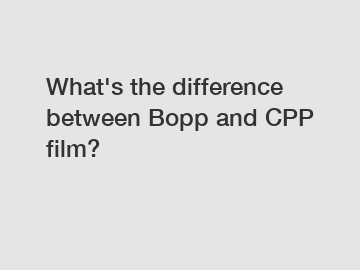What's the difference between Bopp and CPP film?
When it comes to packaging materials, films play a crucial role in keeping our goods safe, fresh, and visually appealing. Among the many types of flexible films, Biaxially Oriented Polypropylene (BOPP) and Cast Polypropylene (CPP) are widely used in a range of industries. While they may seem similar at first glance, understanding the nuances between these two films is vital to make informed packaging decisions. In this article, we will explore the characteristics, applications, and differences between BOPP and CPP films.
Characteristics of BOPP Film (200 words):
BOPP film, made from stretched polypropylene resin, offers exceptional clarity, high tensile strength, and excellent barrier properties. This film type undergoes a specialized manufacturing process called biaxial orientation. It involves stretching the film in both machine and transverse directions, resulting in superior mechanical strength and dimensional stability.

BOPP film boasts excellent printability, allowing vivid and high-quality graphics on its surface. The film's inherent stiffness ensures it remains flat, making it ideal for applications such as labels, flexible packaging, adhesive tape, and many more. Furthermore, BOPP can be treated to enhance its adhesion properties, enabling the lamination with other films or substrates.
Understanding CPP Film (200 words):
CPP film, on the other hand, is produced by the cast extrusion process, where molten polypropylene is cooled and solidified to form a film. Unlike BOPP, CPP film is characterized by its excellent heat sealing capabilities. This property makes it popular for applications that require packaging to be sealed, such as bags, sachets, and wrappers.
CPP film offers high transparency, allowing for optimal product visibility. Its flexibility and durability make it a preferred choice for packaging items with irregular shapes. The film's softness and ability to conform to various contours enable it to wrap products securely, ensuring protection against moisture, dust, and other environmental factors.
Differences between BOPP and CPP Film (200 words):
The primary dissimilarity between BOPP and CPP film lies in their manufacturing processes. BOPP is oriented in both machine and transverse directions, resulting in higher tensile strength compared to CPP. This superior strength makes BOPP ideal for applications where stiffness and dimensional stability are paramount, such as in labels and tapes.
In contrast, CPP film, owing to its cast extruded nature, offers better heat sealing properties than BOPP. This makes CPP the preferred choice for packaging materials requiring secure seals, like bags and wrappers. Additionally, CPP film's inherent flexibility and conformability allow it to adapt to irregularly shaped products with ease.
Applications and Handling Considerations (200 words):
The versatile nature of BOPP and CPP films makes them suitable for various applications across industries. BOPP excels in applications such as food packaging, overwrapping, lamination, and label printing. Its stiffness and impact resistance ensure the integrity and visual appeal of the packaged products. However, BOPP film may not be suitable for applications requiring high-temperature resistance due to its lower melting point.
On the other hand, CPP film finds extensive use in packaging bakery goods, confectionery, textiles, and other products that benefit from its excellent heat sealing capabilities. Its flexibility and seal integrity make CPP film a reliable choice for ensuring the freshness and protection of packaged goods. Moreover, CPP film demonstrates better thermal stability, enabling it to withstand higher temperatures during processing.
Conclusion (100 words):
In conclusion, while both BOPP and CPP films are made from polypropylene, they differ significantly in terms of their manufacturing processes, physical characteristics, and application suitability. BOPP film offers exceptional clarity, printability, and stiffness, making it ideal for applications that prioritize dimensional stability. On the other hand, CPP film excels in heat sealing properties, flexibility, and adaptability. Understanding these differences allows packaging professionals to select the most suitable film for their specific needs, ensuring superior packaging performance and optimizing consumer experiences.
Want more information on metalized plastic, co extruded bopp film history, shrinkage in bopp film? Feel free to contact us.
213
0
0

Comments
All Comments (0)